In recent years, with the rapid development of artificial intelligence (AI) and blockchain technology, the AI+Crypto track has become a hot area of interest for investors. Blockchain, with its characteristics of decentralization, high transparency, low energy consumption, and anti-monopoly, has compensated for the strong centralization and opaque processing of AI systems. The combination of the two has brought us unprecedented opportunities.
According to Vitalik's viewpoint, the combined application of AI and blockchain can be mainly divided into four categories: as application participants, as application interfaces, as application rules, and as application objectives. He suggests that the role of AI in Crypto should be considered more from the perspective of "application," including optimizing computing power, algorithms, and data.
Huobi Research divides the participation directions of Crypto technology according to the application level of AI, which can be divided into the basic layer, execution layer, and application layer, with opportunities worth exploring at each level. For example, zkML technology combines zero-knowledge proofs and blockchain technology to provide a secure, verifiable, and transparent solution for AI agent behavior. In addition, AI has shown great potential in data processing, automated dApp development, and on-chain transaction security at the execution level. At the application level, AI-driven trading bots, predictive analysis tools, and AMM liquidity management play important roles in the DeFi field.
This article will discuss in detail the investment direction of the AI+Crypto track, focusing on the innovation and development at the infrastructure and application levels, and analyzing the prospects and challenges of the combination of AI and blockchain from the perspective of mid-term and long-term investment strategies.
Key Directions of the AI Track
Blockchain is completely opposite to artificial intelligence in terms of centralization, low transparency, energy consumption, and monopolization. According to Vitalik's criteria and his own thinking, the applications formed by the combination of artificial intelligence and blockchain can be divided into four major categories:
- AI as a player in a game
- AI as an interface to the game
- AI as the rules of the game
- AI as the objective of the game
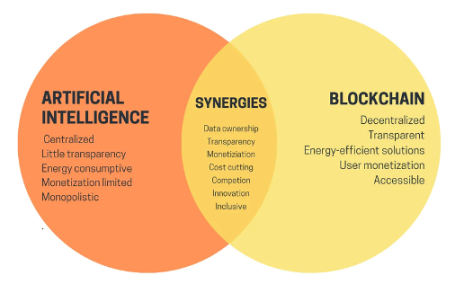
Vitalik's perspective on the role of AI in Crypto is more focused on the "application" aspect. If we consider it from the perspective of productivity vs. production relations, Crypto actually provides more of the production relations. From this point of view, it can mainly be considered from three directions:
- Optimizing computing power: providing decentralized and efficient computing resources, reducing the risk of single points of failure, and improving overall computing efficiency.
- Optimizing algorithms: promoting the open-source, sharing, and innovation of algorithms or models.
- Optimizing data: decentralized storage, contribution, use, and secure management of data.
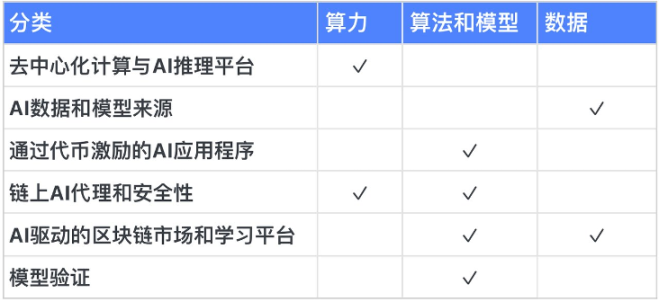
HTX Research believes that the overall direction of AI can be divided into the basic layer, execution layer, and application layer according to the general architecture. Correspondingly, we can also explore AI+Web3 projects from these three major directions. At the basic layer, it includes model training at the infrastructure level, data, decentralized computing power, and hardware, with a focus on the combination of zk technology and AI ML technology; at the execution layer, it involves data processing and data transmission, AI agent at the model level, zkML, FHE (Fully Homomorphic Encryption), etc.; at the application layer, it mainly focuses on AI+DeFi, AI+GameFi, metaverse, AIGC, Meme, as well as blockchain-level RAAS (Robotics as a Service), oracles, coprocessors, UBI (Universal Basic Income), etc.
The development of projects at the infrastructure and application levels is relatively fast, such as Io.net in the computing power level, Flock in the basic model level, ZeroGravity in blockchain infrastructure, Myshell and 0xScope at the application level.
The following key directions can be explored:
I. Direction of zkML
zkML technology provides a secure, verifiable, and transparent solution for monitoring and constraining AI agent behavior by combining zero-knowledge proofs and blockchain technology. For example, the Modulus Labs project uses zkML technology to prove to stakeholders that its AI has performed specific tasks while protecting personal privacy and business secrets.
zkML, as an intermediary between artificial intelligence and blockchain, proposes a set of solutions aimed at addressing privacy protection issues between AI models and inputs, and ensures the verifiability of the reasoning process. It introduces a new method that can use public models to verify private data or use public data to verify private models when verifying private data. By integrating the capabilities of machine learning, smart contracts can achieve more autonomy and dynamism, and can operate based on real-time on-chain data, rather than just static rules. This innovation makes smart contracts more flexible and adaptable to a wider range of application scenarios, including those that were not foreseen when the contract was initially set.
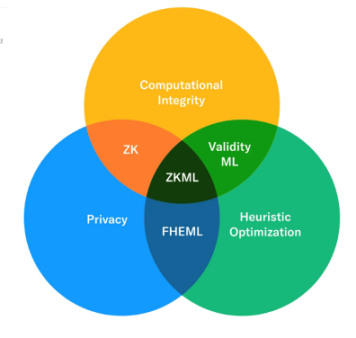
Introduction to Typical Projects of zkML Technology
Modulus Labs
Modulus Labs is one of the most diverse projects in the ZKML field, actively building on-chain AI application examples while conducting related research. They demonstrate the use cases of zkML through RockyBot (on-chain trading bot) and Leela vs. the World (a chess game). They have also conducted benchmark tests on the speed and efficiency of various verification systems for models of different sizes.
Giza
Giza is a protocol for deploying AI models on-chain, using a technology stack that includes ONNX format for machine learning models, Giza Transpiler for converting these models into Cairo program format, ONNX Cairo Runtime for executing models in a verifiable and deterministic manner, and Giza Model smart contract for deploying and executing on-chain models. Overall, Giza is a compiler from machine learning models to proofs on-chain, providing an alternative path for the development of on-chain AI.
Zkaptcha
Zkaptcha focuses on the issue of bots in Web3, providing captcha services for smart contracts using zero-knowledge proofs to create anti-Sybil attack smart contracts. The project enables end users to generate proof of human work by completing a captcha, which is then verified by on-chain validators. They plan to inherit zkML and introduce a service similar to existing Web 2 captcha services, and may even analyze mouse movements and other behaviors to determine if the user is human.
II. Data Processing Direction
This mainly refers to various breakthroughs of AI at the execution level, especially for some blockchain data transmission and development at the development level. The specific analysis is as follows:
a. AI and on-chain data analysis
This direction mainly refers to using AI technology to deeply explore these data, using LLM large models and deep learning algorithms to gain more insights. For example, the Web3 Analytics project uses AI for on-chain data analysis, revealing market trends and user behavior. It can help users gain insights into on-chain transactions and market trends.
b. AI and automated dApp development
This direction mainly targets some infrastructure projects for DevOps. AI projects using automated development can attract more developers, making the ecosystem more prosperous. Some AI-based development tools can also help developers write smart contracts more quickly and automatically correct errors, and some can even achieve drag-and-drop DApp programming functionality.
c. AI and on-chain transaction security
This direction mainly involves AI agents. It involves deploying AI agents on the blockchain to enhance the security and trustworthiness of AI applications. These AI agents can automatically perform tasks such as transactions, data analysis, and automated decision-making, and deploying them on the blockchain makes their operations not only transparent and traceable but also difficult to tamper with, thereby enhancing the overall system's security. AI technology can identify and defend against malicious attacks and data breaches through real-time monitoring and intelligent analysis, ensuring transaction security and data integrity.
Project Examples:
SeQure is a security platform that uses AI for real-time monitoring and analysis, detecting and defending against various malicious attacks and data breaches, ensuring the stability and security of on-chain transactions.
III. AI+DEFI Direction
The combination of AI and the application layer is most important in AI+DEFI. Here are some AI+DEFI directions to pay attention to:
- AI-driven trading bots
These bots can execute trades quickly and accurately, analyze market data, news sentiment, and price trends, and make instant trading decisions, often outperforming human traders.
- Predictive analysis
Although predicting fluctuations in the crypto market has always been a challenge, AI-driven analysis tools are gradually becoming an important tool, providing reliable predictions of market trends and potential price movements.
- AMM liquidity management
For example, when adjusting the liquidity range of Uniswap V3, through AI integration, the protocol can intelligently adjust the liquidity range to optimize the efficiency and returns of automated market makers (AMMs).
- Liquidation protection and debt position management
By combining on-chain and off-chain data, liquidation protection strategies can be implemented more intelligently to ensure the protection of debt positions during market fluctuations.
- Complex DeFi structured product design
When designing treasury mechanisms, reliance on financial AI models instead of fixed strategies can be leveraged. These strategies may include AI-managed trading, lending, or options, adding intelligence and flexibility to the products.
IV. AI+GameFi Direction
The application of AI in GameFi projects mainly enriches the gaming experience and increases the potential for innovation. The main directions are as follows:
- Game strategy optimization:
AI can adjust game difficulty and strategy in real-time by learning players' gaming habits and strategies, providing a more personalized and challenging gaming experience. Through deep learning and reinforcement learning, AI can self-evolve to better meet the needs and preferences of players.
- Game asset utilization management:
AI technology can help players more effectively manage and trade virtual assets within games. Using smart contracts and automated trading strategies, players can maximize the utilization of assets, such as automatic buying, selling, leasing, and borrowing game assets, thereby optimizing investment returns.
- Enhanced game interaction:
AI can create more intelligent and responsive non-player characters (NPCs), achieving more natural and seamless interaction with players through natural language processing (NLP) and machine learning (ML) technologies, enhancing game immersion and player satisfaction.
In terms of investment strategies over time:
- In the short term, attention should be focused on the initial landing areas of AI in Crypto, such as some conceptual AI applications and memes. Logic: This year, the mainstream AI circle will continue to generate new hotspots, and each upgrade of large models by companies like NVIDIA and OpenAI in the Web2 space will ignite the hotspots of the AI track, bringing in new funds, which will ignite the emotional aspect of this track.
- In the medium term, the combination of AI agents and intent, and the combination with smart contracts, is a highlight. Once AI successfully provides solutions for smart contract extensions, it will form a new type of blockchain with ledger + contract + AI, breaking the narrative of the ledger + contract era of Ethereum.
- Among them, AI agent is a subdivision direction mentioned by Vitalik. AI Agent refers to an AI agent that can autonomously acquire information from the environment, process information, make decisions, execute tasks, and autonomously change the environment. AI Agent currently belongs to the forefront of the AI field, the application layer closest to mass adoption.
- Narratively speaking, AI Agent is the sexy and hot beauty, GPU cloud computing power is the stable and mature middle-aged entrepreneur, and the integration of AI large models at the DA layer is the disheveled scientist.
- In the long term, the combination of AI and zkML technology (although the ML experts of Web2 AI companies look down on AI in Crypto) will ultimately impact the Crypto field.
References
Twitter: https://twitter.com/FinanceYF5/status/1772434625387717055
Web3Caff: https://twitter.com/Web3Caff_Res
Twitter Vitalik: https://twitter.com/VitalikButerin
Appendix:
List of Decentralized Computing and AI Reasoning Platform Projects
Mainly refers to using Crypto for incentives to share and utilize idle computing resources globally.
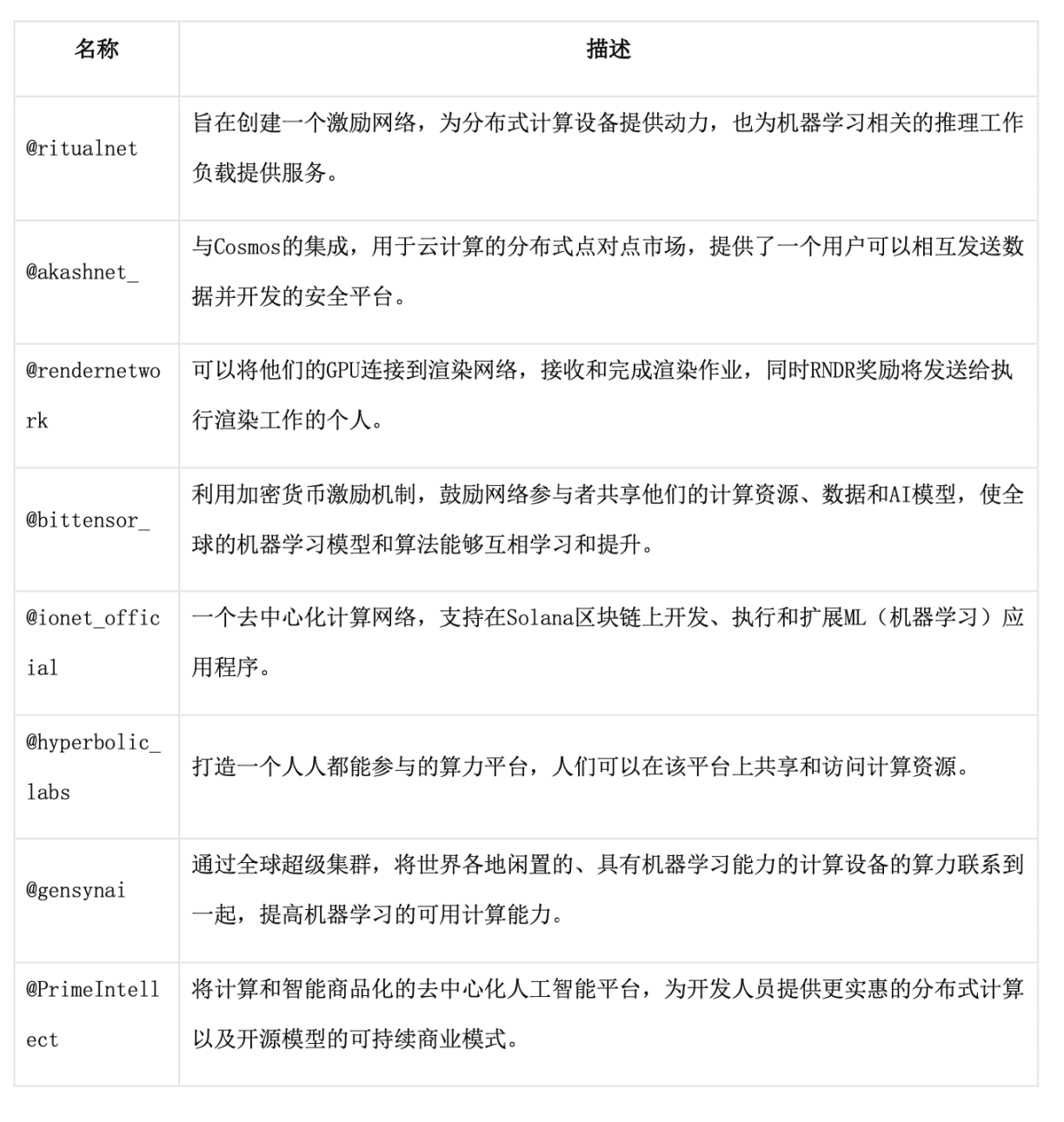
AI Data and Model Source Project List
This mainly uses Crypto economic models to incentivize data (for C-end users) and model (for Dev, B-end) aspects based on the authenticity, transparency, and traceability of data.
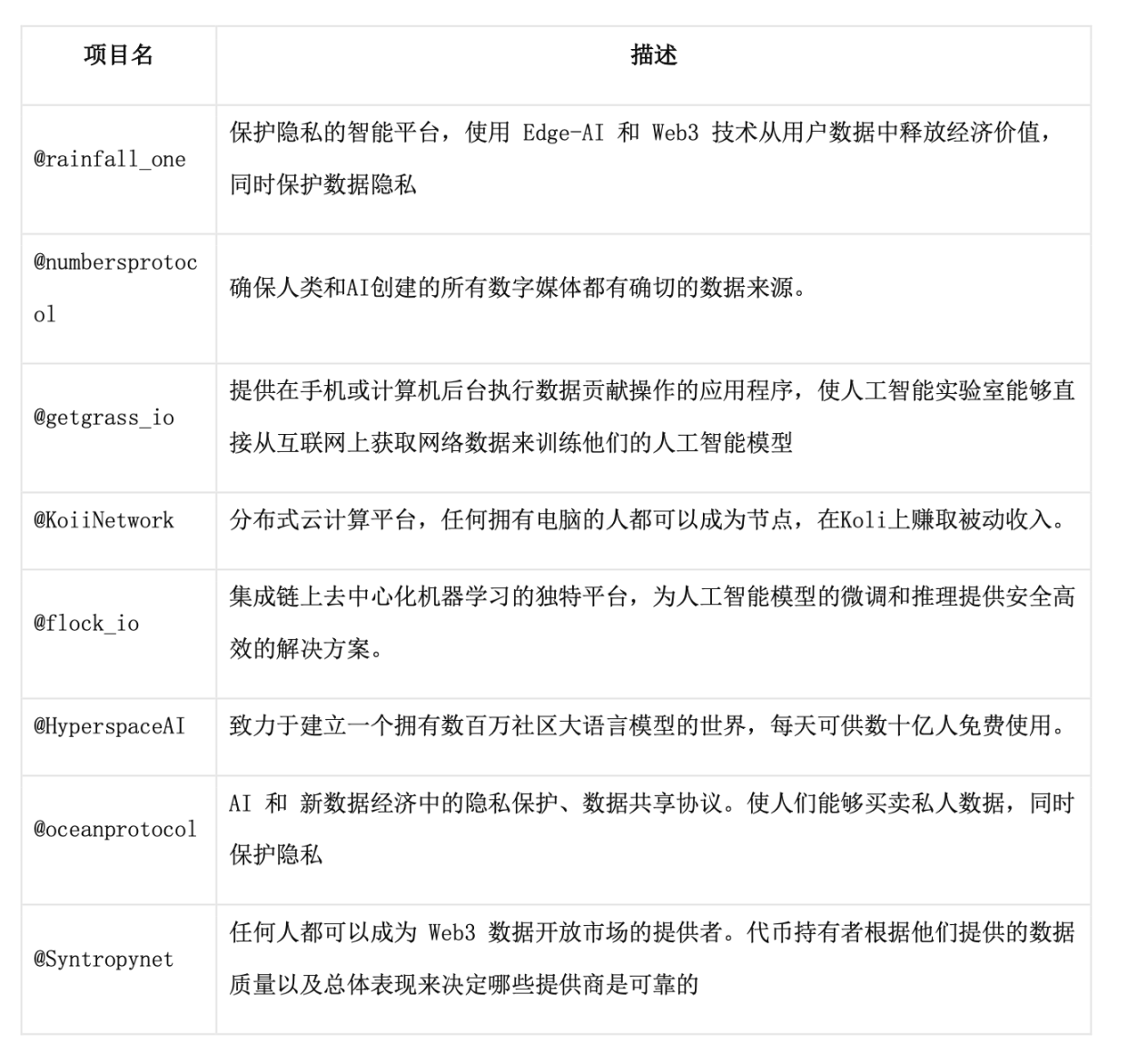
免责声明:本文章仅代表作者个人观点,不代表本平台的立场和观点。本文章仅供信息分享,不构成对任何人的任何投资建议。用户与作者之间的任何争议,与本平台无关。如网页中刊载的文章或图片涉及侵权,请提供相关的权利证明和身份证明发送邮件到support@aicoin.com,本平台相关工作人员将会进行核查。




